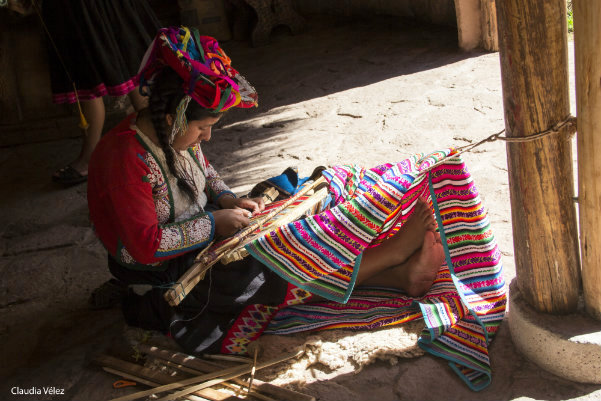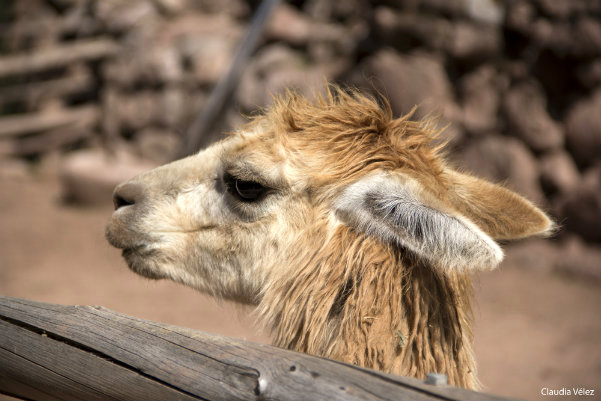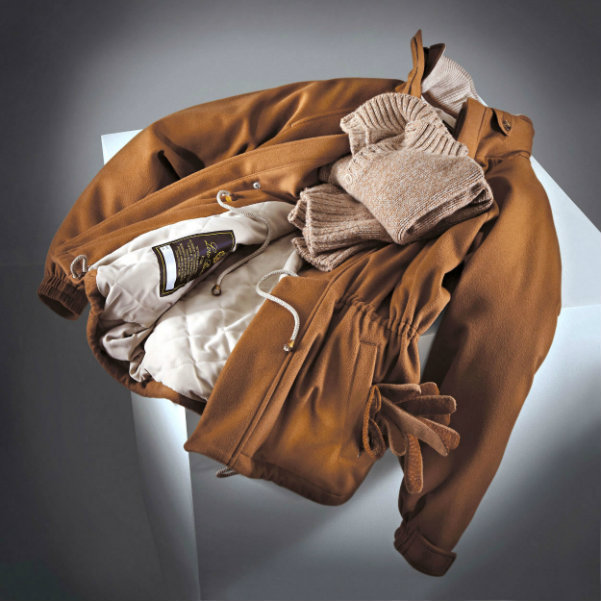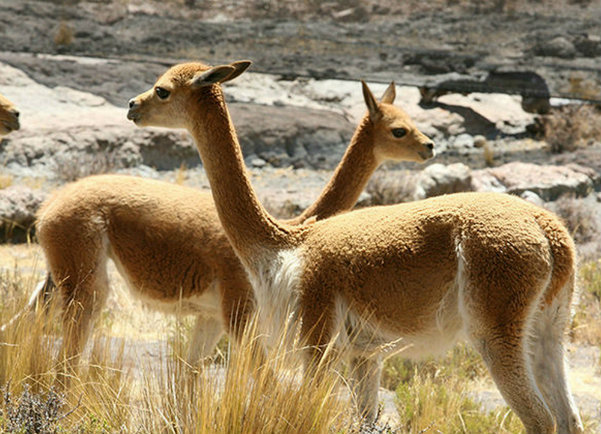They weigh about 45 kilos and do not exceed 80 cm in height, but its “precious wool” is sold at astronomical prices: up to $500 is paid for a kilo of unprocessed vicuna fiber. This is a tough, warm and also very limited material, as the population of these animals was reduced considerably during the last century. Today, to find them grazing, you must visit South America: Horse Magazine was there.

View of the vicunas grazing on a plain in Arequipa (Peru), with the Misti volcano in the background
More specifically, the National Reserve of Salinas and Aguada Blanca located between the Peruvian departments of Arequipa and Moquegua, is more than 4,000 meters in altitude. The reserve was created in 1979 to ensure the protection of the vicuñas living in the area and that live with alpacas, llamas and guanacos. Hundreds of vicunas scamper freely around the road linking Arequipa, Peru’s second-largest city, with Chivay, a small town at the entrance of the Colca Canyon.

Vicuna grazing free in Aguada Blanca National Reserve
There, amid the inhospitable Andean highlands, groups of vicuñas intertwine in search of food; and sellers of this precious animal fiber (street vendors serve from the alcohol of pharmaceutical use to cope with altitude sickness). Their wool is a treasure that has been highly acclaimed: the most powerful king of history, Philip II, demanded it to sleep; and its use by many Hollywood stars and other characters took on the brink of its extinction. That is why the Peruvian government banned exports until 1994 and launched a major recovery plan.

Knitter camelid fibers Awanacancha (Palace of the Fabrics) – Cuzco
The sacred animal of the Incas, whose golden fur confuses with the Andean landscape in which they live, gives its unique natural fiber to diminish the misery of the inhabitants of one of the poorest areas of Peru, while delights the wealthy people attending the most luxurious catwalks. It is a scarce commodity, and so coveted, that has banished the finest wools as cashmere (Asian goat) or shahtoosh (Tibetan antelope), to establish itself as the queen of luxury textiles.

Close-up of a vicuna of Peru area
With beautiful and huge black eyes and a lengthy neck, this limited wild animal produces a hair prized for its warmth (its fibers have scales that when put together interwove and isolate air), and for its fineness: it measures between 12 and 14 microns diameter. It is an animal fiber whose raw kilo reaches $300 to $500 (250 to 420 euros), depending on the quality; and it costs so much because a vicuna only produces 200 grams of fiber every three years. Making it difficult to get several meters of this fabric. Moreover, its hair is very short and fine, it is difficult to spin.

Vicuña fiber – Vicuna – Reserve Dr. Franco Loro Piana (Pampa Galeras)
31,000 euros for a suit of Vicuna
The vicuna is characterized by its brown cinnamon color in the back and side of the body, along the neck and in the back portion of the head; while in the chest, belly, inside of the legs and lower part of the head the color is white. Vicuna fiber is commercially grouped under the denomination “fine, appreciated or precious” woolen fibers. Only about four tons are exported annually to Italy, England, Germany and the United States.

Garments made in vicuna – Ermenegildo Zegna – Fall 2014/2015
The massification of materials that were once synonymous with luxury has led to iconic fashion houses to scour the world in search of substitutes. Including Ermenegildo Zegna, whose goal remains to create the most beautiful fabrics in the world and fight to preserve the quality of Peruvian vicuna wool, one of the finest and most expensive in the world. He maximizes the development of water facilities in the Picotaini community (Puno-Peru) with his “Vicuna” project because drinking water is essential for both breeders of vicuna and for their livestock, improving the survival of the species and its capacity for reproduction.

Icer jacket in vicuna €15.650 – Sweater Mezzocollo in vicuna and baby cashmere €4.100 – Gloves Monaco in vicuna €1.150
Meanwhile, the Italian brand Loro Piana, synonymous with global textile crafts, has gotten most of the world’s supply of this valuable raw material. It has done this thanks to its Private Reserve Dr Franca Loro Piana, located in Pampa Galeras (Ayacucho-Peru), to make their products better. As a result, the population of this animal, which came to be in danger of extinction, has rebounded strongly; demonstrating that fashion is capable of promoting sustainability and the preservation of the environment and its wildlife.

Vicuna wool tunic €5.720 – Jacket fantasy in vicuna and baby cashmere €6.960 – Stole in vicuna €4.550
Jack Nicholson, Robert De Niro and Daniel Craig among others dress up in suits of vicuña fiber. A coat made of this animal, for which it would take twenty–five to thirty vicunas would cost in Peru up to €9,000; while in the United States or Europe they would pay about €20,000 for a jacket or €31,000 for a suit made of this soft fabric.
The “Chaku” tradition for preservation

Traditional Ceremony of “Chaku” – Vicuna – Reserve Dr. Franco Loro Piana (Pampa Galeras)
Vicunas are fearful animals that graze peacefully as usual and that only once a year, are bothered by the locals who gather to catch and shear them. Following the Inca tradition (related by Inca Garcilaso de la Vega in his “Royal Commentaries of the Incas”) every three years the “Chaku” was celebrated. It is the ceremony where they captured, sheared and took the census of the population of this Andean camelid; This rodeo is repeated today as an example of the high value of its fiber can be used in favor of preservation.

Traditional Ceremony of “Chaku” – Vicuna – Reserve Dr. Franco Loro Piana (Pampa Galeras)
The vicuna population hovered between one and two million copies in pre-Columbian times, but after the arrival of the Spaniards and their indiscriminate hunting in order to bring its fiber to Europe, it was in danger of extinction. Thanks to the Convention on the Conservation and Management of the Vicuna, signed between Peru, Bolivia, Chile and Argentina, it has made possible the recovery of this camelid, recognizing that the cheapest and most effective way to protect the vicuna population is to keep them wild. Currently, it is only allowed to shear it and trade with the fiber and fabrics; it is a protected species by law, whose hunting is punishable by imprisonment up to five years.

Vicunas – Reserve Dr. Franco Loro Piana (Pampa Galeras)
The vicuna is one of the four species of “auquénidos” popular name for the Southern Andes camelids. Two of them are domestic: the alpaca (Lama pacos) and the llama (Lama glama); and two wild: the guanaco (Lama guanicoe) and the vicuna (Vicugna vicugna). Distributed along the Andean Mountains in South America from Ecuador to Tierra del Fuego, there is a greater concentration in the Peruvian-Bolivian highlands and northern Chile and Argentina, at altitudes between 3,800 and 5,000 meters. The wool of these South-America camelids is part of the market of special fine fibers.
The most expensive animal fiber in the world, which in ancient times dressed up the Inca and the royalty, dresses up today the millionaires in the world.
Images courtesy of Gaby Fil , Claudia Velez and loropiana.com
Translator: Raquel Sánchez




